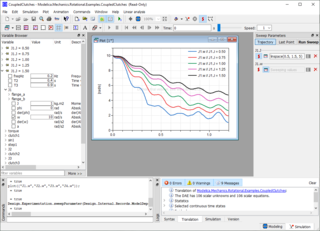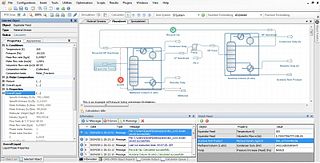Related Research Articles
Control theory deals with the control of dynamical systems in engineered processes and machines. The objective is to develop a model or algorithm governing the application of system inputs to drive the system to a desired state, while minimizing any delay, overshoot, or steady-state error and ensuring a level of control stability; often with the aim to achieve a degree of optimality.

The Norwegian Institute of Technology was a science institute in Trondheim, Norway. It was established in 1910, and existed as an independent technical university for 58 years, after which it was merged into the University of Trondheim as an independent college.
The field of system identification uses statistical methods to build mathematical models of dynamical systems from measured data. System identification also includes the optimal design of experiments for efficiently generating informative data for fitting such models as well as model reduction. A common approach is to start from measurements of the behavior of the system and the external influences and try to determine a mathematical relation between them without going into many details of what is actually happening inside the system; this approach is called black box system identification.
An industrial process control in continuous production processes is a discipline that uses industrial control systems to achieve a production level of consistency, economy and safety which could not be achieved purely by human manual control. It is implemented widely in industries such as automotive, mining, dredging, oil refining, pulp and paper manufacturing, chemical processing and power generating plants.
Model predictive control (MPC) is an advanced method of process control that is used to control a process while satisfying a set of constraints. It has been in use in the process industries in chemical plants and oil refineries since the 1980s. In recent years it has also been used in power system balancing models and in power electronics. Model predictive controllers rely on dynamic models of the process, most often linear empirical models obtained by system identification. The main advantage of MPC is the fact that it allows the current timeslot to be optimized, while keeping future timeslots in account. This is achieved by optimizing a finite time-horizon, but only implementing the current timeslot and then optimizing again, repeatedly, thus differing from a linear–quadratic regulator (LQR). Also MPC has the ability to anticipate future events and can take control actions accordingly. PID controllers do not have this predictive ability. MPC is nearly universally implemented as a digital control, although there is research into achieving faster response times with specially designed analog circuitry.

Modelica is an object-oriented, declarative, multi-domain modeling language for component-oriented modeling of complex systems, e.g., systems containing mechanical, electrical, electronic, hydraulic, thermal, control, electric power or process-oriented subcomponents. The free Modelica language is developed by the non-profit Modelica Association. The Modelica Association also develops the free Modelica Standard Library that contains about 1400 generic model components and 1200 functions in various domains, as of version 4.0.0.
In control theory, Advanced process control (APC) refers to a broad range of techniques and technologies implemented within industrial process control systems. Advanced process controls are usually deployed optionally and in addition to basic process controls. Basic process controls are designed and built with the process itself, to facilitate basic operation, control and automation requirements. Advanced process controls are typically added subsequently, often over the course of many years, to address particular performance or economic improvement opportunities in the process.
Advanced process monitor (APMonitor) is a modeling language for differential algebraic (DAE) equations. It is a free web-service or local server for solving representations of physical systems in the form of implicit DAE models. APMonitor is suited for large-scale problems and solves linear programming, integer programming, nonlinear programming, nonlinear mixed integer programming, dynamic simulation, moving horizon estimation, and nonlinear model predictive control. APMonitor does not solve the problems directly, but calls nonlinear programming solvers such as APOPT, BPOPT, IPOPT, MINOS, and SNOPT. The APMonitor API provides exact first and second derivatives of continuous functions to the solvers through automatic differentiation and in sparse matrix form.

Willis Harmon Ray is an American chemical engineer, control theorist, applied mathematician, and a Vilas Research emeritus professor at the University of Wisconsin–Madison notable for being the 2000 winner of the prestigious Richard E. Bellman Control Heritage Award and the 2019 winner of the Neal Amundson Award.

Dymola is a commercial modeling and simulation environment based on the open Modelica modeling language.

Process simulation is used for the design, development, analysis, and optimization of technical processes such as: chemical plants, chemical processes, environmental systems, power stations, complex manufacturing operations, biological processes, and similar technical functions.
An online model is a mathematical model which tracks and mirrors a plant or process in real-time, and which is implemented with some form of automatic adaptivity to compensate for model degradation over time.
JModelica.org is a commercial software platform based on the Modelica modeling language for modeling, simulating, optimizing and analyzing complex dynamic systems. The platform is maintained and developed by Modelon AB in collaboration with academic and industrial institutions, notably Lund University and the Lund Center for Control of Complex Systems (LCCC). The platform has been used in industrial projects with applications in robotics, vehicle systems, energy systems, CO2 separation and polyethylene production.
Moving horizon estimation (MHE) is an optimization approach that uses a series of measurements observed over time, containing noise and other inaccuracies, and produces estimates of unknown variables or parameters. Unlike deterministic approaches, MHE requires an iterative approach that relies on linear programming or nonlinear programming solvers to find a solution.
Simcenter Amesim is a commercial simulation software for the modeling and analysis of multi-domain systems. It is part of systems engineering domain and falls into the mechatronic engineering field.
System-level simulation (SLS) is a collection of practical methods used in the field of systems engineering, in order to simulate, with a computer, the global behavior of large cyber-physical systems.
Aspen Plus, Aspen HYSYS, ChemCad and MATLAB, PRO are the commonly used process simulators for modeling, simulation and optimization of a distillation process in the chemical industries. Distillation is the technique of preferential separation of the more volatile components from the less volatile ones in a feed followed by condensation. The vapor produced is richer in the more volatile components. The distribution of the component in the two phase is governed by the vapour-liquid equilibrium relationship. In practice, distillation may be carried out by either two principal methods. The first method is based on the production of vapor boiling the liquid mixture to be separated and condensing the vapors without allowing any liquid to return to the still. There is no reflux. The second method is based on the return of part of the condensate to still under such conditions that this returning liquid is brought into intimate contact with the vapors on their way to condenser.
Cybernetica may refer to:

Håvard Fjær Grip is a Norwegian cybernetics engineer, adjunct assistant professor and robotics technologist. He leads the Flight Control Team and is Chief Pilot for NASA's Jet Propulsion Laboratory Mars helicopter, Ingenuity. Grip successfully flew Ingenuity's first flight on Mars on April 19, 2021, making history as the first extraterrestrial helicopter flight.
References
- ↑ Financial Data - historical summary of financial data from annual reports
- ↑ "CYBERNETICA | REALISE-CCUS". realiseccus.eu. Retrieved 2022-06-14.
- 1 2 "Lønnsom Matematikk" - News paper article in "Teknisk Ukeblad" from 2001 (Norwegian)
- ↑ "Model-Based Optimizing Control and Estimation using Modelica Models" (PDF). Modelica.org. Retrieved 29 December 2017.
- ↑ "Using Modelica models in real time dynamic optimization – gradient computation" (PDF). Ep.liu.se. Retrieved 29 December 2017.
- ↑ "Cybernetica AS - Model based control systems for the process industry". Archived from the original on 2012-03-29. Retrieved 2011-10-11.
- ↑ "Norsk Forening for Automatisering". Nfaplassen.no. Retrieved 28 December 2017.
- ↑ "Archived copy" (PDF). Archived from the original (PDF) on 2012-03-30. Retrieved 2011-10-11.
{{cite web}}: CS1 maint: archived copy as title (link) - ↑ "Archived copy" (PDF). Archived from the original (PDF) on 2012-03-30. Retrieved 2011-10-11.
{{cite web}}: CS1 maint: archived copy as title (link) - ↑ "Archived copy" (PDF). Archived from the original (PDF) on 2012-03-30. Retrieved 2011-10-11.
{{cite web}}: CS1 maint: archived copy as title (link) - ↑ "Cybernetica AS - Model based control systems for the process industry". Archived from the original on 2012-04-25. Retrieved 2011-10-11.
- ↑ "Cybernetica AS | Trondheim, Norway | – ResearchGate".